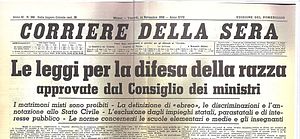
| Part of a series on |
| Fascism |
|---|
 |
Initially, Fascist Italy did not enact comprehensive racist policies like those policies which were enacted by its World War II Axis partner Nazi Germany. Italy's National Fascist Party leader, Benito Mussolini, expressed different views on the subject of race over the course of his career. In an interview conducted in 1932 at the Palazzo di Venezia in Rome, he said "Race? It is a feeling, not a reality: ninety-five percent, at least, is a feeling. Nothing will ever make me believe that biologically pure races can be shown to exist today".[2]
By 1938, however, he began to actively support racist policies in the Italian Fascist regime, as evidenced by his endorsement of the "Manifesto of Race", the seventh point of which stated that "it is time that Italians proclaim themselves to be openly racist",[3] although Mussolini said that the Manifesto was endorsed "entirely for political reasons", in deference to Nazi German wishes.[4] The "Manifesto of Race", which was published on 14 July 1938, paved the way for the enactment of the Racial Laws.[1] Leading members of the National Fascist Party (PNF), such as Dino Grandi and Italo Balbo, reportedly opposed the Racial Laws.[5] Balbo, in particular, regarded antisemitism as having nothing to do with fascism and he staunchly opposed the antisemitic laws.[6]
After 1938, discrimination and persecution intensified and became an increasingly important hallmark of Italian Fascist ideology and policies.[7] Nevertheless, Mussolini and the Italian military did not consistently apply the laws adopted in the Manifesto of Race.[8] In 1943, Mussolini expressed regret for the endorsement, saying that it could've been avoided.[9] After the Second Italo-Ethiopian War, the Italian Fascist government implemented strict racial segregation between white people and black people in Ethiopia.[10]
- ^ a b Shinn, Christopher A. (2019) [2016]. "Inside the Italian Empire: Colonial Africa, Race Wars, and the 'Southern Question'". In Kirkland, Ewan (ed.). Shades of Whiteness. Leiden and Boston: Brill Publishers. pp. 35–51. doi:10.1163/9781848883833_005. ISBN 978-1-84888-383-3. S2CID 201401541.
- ^ Talks with Mussolini
- ^ "The Manifesto of Race" (PDF). 1938. Archived from the original (PDF) on 14 April 2016. Retrieved 1 March 2019.
- ^ Hibbert, Christopher (1962). Il Duce; the Life of Benito Mussolini. Little, Brown. p. 87.
- ^ Gunther, John (1940). Inside Europe. New York: Harper & Brothers. p. 262.
- ^ Cite error: The named reference
autogenerated1999was invoked but never defined (see the help page). - ^ Goeschel, Christian (March 2017). "Staging Friendship: Mussolini and Hitler in Germany in 1937". The Historical Journal. 60 (1). Cambridge and New York: Cambridge University Press: 149–172. doi:10.1017/S0018246X15000540. ISSN 1469-5103. S2CID 156952523.
- ^ Kroener, Bernhard R.; Muller, Rolf-Dieter; Umbreit, Hans (2003). Germany and the Second World War Organization and Mobilization in the German Sphere of Power. Vol. VII. New York: Oxford University Press p. 247
- ^ Gillette, Aaron (14 January 2004). Racial Theories in Fascist Italy. Taylor & Francis. p. 95. ISBN 978-0-203-16489-1.
- ^ Robertson, E.M. (1988). "Race as a Factor in Mussolini's Policy in Africa and Europe". Journal of Contemporary History. 23 (1): 37–58. doi:10.1177/002200948802300103. ISSN 0022-0094. S2CID 161818702.
